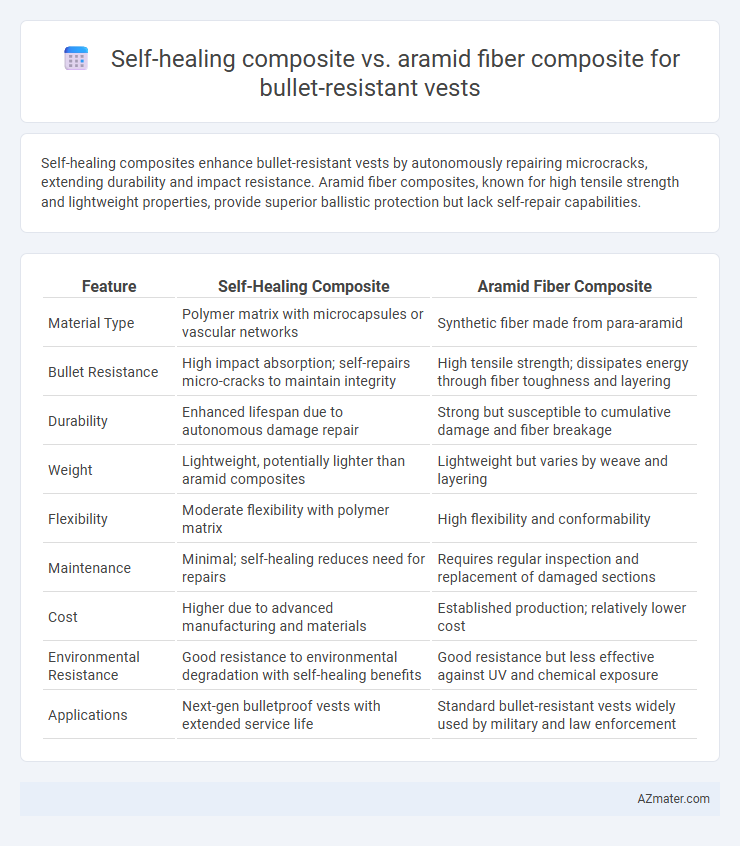Self-healing composites enhance bullet-resistant vests by autonomously repairing microcracks, extending durability and impact resistance. Aramid fiber composites, known for high tensile strength and lightweight properties, provide superior ballistic protection but lack self-repair capabilities.
Table of Comparison
| Feature | Self-Healing Composite | Aramid Fiber Composite |
|---|---|---|
| Material Type | Polymer matrix with microcapsules or vascular networks | Synthetic fiber made from para-aramid |
| Bullet Resistance | High impact absorption; self-repairs micro-cracks to maintain integrity | High tensile strength; dissipates energy through fiber toughness and layering |
| Durability | Enhanced lifespan due to autonomous damage repair | Strong but susceptible to cumulative damage and fiber breakage |
| Weight | Lightweight, potentially lighter than aramid composites | Lightweight but varies by weave and layering |
| Flexibility | Moderate flexibility with polymer matrix | High flexibility and conformability |
| Maintenance | Minimal; self-healing reduces need for repairs | Requires regular inspection and replacement of damaged sections |
| Cost | Higher due to advanced manufacturing and materials | Established production; relatively lower cost |
| Environmental Resistance | Good resistance to environmental degradation with self-healing benefits | Good resistance but less effective against UV and chemical exposure |
| Applications | Next-gen bulletproof vests with extended service life | Standard bullet-resistant vests widely used by military and law enforcement |
Introduction to Bullet-Resistant Materials
Bullet-resistant vests utilize advanced materials designed to absorb and disperse projectile energy, with self-healing composites and aramid fiber composites representing two critical innovations in this field. Aramid fiber composites, such as Kevlar, are widely recognized for their exceptional tensile strength and lightweight properties, enabling reliable ballistic protection. Emerging self-healing composites incorporate microcapsules or polymer networks that autonomously repair micro-damages, enhancing durability and extending the service life of bullet-resistant vests.
Overview of Aramid Fiber Composites
Aramid fiber composites, primarily composed of polyaramid fibers such as Kevlar, offer exceptional tensile strength and impact resistance, making them a standard material in bullet-resistant vests. These composites provide lightweight protection combined with high durability and energy absorption capabilities, effectively dispersing ballistic impact forces. Their molecular structure, characterized by strong hydrogen bonds and crystalline regions, contributes to superior thermal stability and abrasion resistance essential for personal protective equipment.
Understanding Self-Healing Composite Technology
Self-healing composite technology integrates microcapsules or vascular networks within the matrix to autonomously repair damages caused by ballistic impacts, enhancing the durability and lifespan of bullet-resistant vests. In contrast, Aramid fiber composites, such as Kevlar, offer high tensile strength and energy absorption but lack intrinsic self-repair capabilities, often necessitating replacement after significant trauma. The ability of self-healing composites to restore structural integrity without manual intervention presents a transformative advantage in protective gear performance and maintenance.
Comparative Ballistic Performance
Self-healing composites exhibit superior ballistic performance by autonomously repairing micro-cracks caused by projectile impacts, thereby maintaining structural integrity and extending vest lifespan. In contrast, aramid fiber composites provide high initial resistance to ballistic penetration due to their tensile strength and energy absorption but lack self-repair capabilities, leading to permanent damage after multiple impacts. Comparative tests show self-healing composites reduce material degradation and improve multi-hit survivability compared to conventional aramid fiber vests.
Durability and Damage Tolerance
Self-healing composites enhance durability in bullet-resistant vests by autonomously repairing micro-cracks and impact damage, significantly extending the material's lifespan compared to traditional Aramid fiber composites. Aramid fibers offer high tensile strength and resistance to penetration but lack intrinsic damage tolerance, making them susceptible to cumulative impact degradation over time. The integration of self-healing polymers within composite matrices leads to improved damage tolerance, reducing maintenance needs and increasing safety for prolonged ballistic protection.
Weight and Comfort Considerations
Self-healing composites exhibit superior damage resilience but often have higher weight compared to Aramid fiber composites, which are renowned for their lightweight and high tensile strength, enhancing wearer comfort in bullet-resistant vests. Aramid fibers like Kevlar provide excellent flexibility and breathability, significantly reducing fatigue during extended use. The balance between enhanced durability and ergonomic comfort emphasizes the importance of material selection based on mission-specific weight constraints and mobility requirements.
Longevity and Maintenance
Self-healing composites enhance bullet-resistant vests by autonomously repairing micro-damage, significantly extending the vest's longevity and reducing maintenance frequency compared to traditional Aramid fiber composites. Aramid fiber composites, while offering high tensile strength and impact resistance, require regular inspections and potential replacements after ballistic impacts. The integration of self-healing polymers in composite matrices leads to improved durability and cost-effectiveness over the vest's operational life.
Cost Analysis and Manufacturing Processes
Self-healing composites, incorporating microcapsules or vascular networks to repair damage, generally involve higher material and manufacturing costs compared to traditional Aramid fiber composites used in bullet-resistant vests. Aramid fiber composites, such as Kevlar, benefit from established manufacturing processes like weaving and resin molding, which are cost-effective and scalable for mass production. The advanced fabrication techniques required for self-healing composites increase production complexity and expenses, making Aramid fiber composites more economically viable for large-scale bullet-resistant vest manufacturing.
Real-world Applications and Case Studies
Self-healing composites in bullet-resistant vests demonstrate enhanced durability by autonomously repairing micro-cracks caused by ballistic impacts, extending the vest's lifespan in tactical operations. Case studies reveal these composites maintain structural integrity post-impact, reducing the need for immediate replacement compared to traditional Aramid fiber composites, which offer high tensile strength but lack self-repair capabilities. Real-world applications in military and law enforcement settings highlight self-healing composites' potential to improve soldier safety and operational readiness through sustained protective performance.
Future Trends in Bullet-Resistant Vest Materials
Self-healing composites offer promising advancements in bullet-resistant vests by enhancing durability and extending service life through automatic damage repair, reducing maintenance frequency. Aramid fiber composites, known for exceptional tensile strength and lightweight properties, continue to evolve with nanotechnology integrations to improve impact resistance and flexibility. Future trends indicate a convergence of self-healing capabilities with high-performance aramid fibers, aiming to create multifunctional vests that provide superior protection, comfort, and sustainability.

Infographic: Self-healing composite vs Aramid fiber composite for Bullet-resistant vest
 azmater.com
azmater.com